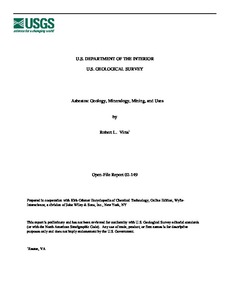Asbestos : geology, mineralogy, mining, and uses
"The term asbestos is a generic designation referring usually to six types of naturally occurring mineral fibers that are or have been commercially exploited. These fibers belong to two mineral groups: serpentines and amphiboles. The serpentine group contains a single asbestiform variety: chrys...
| Main Author: | |
|---|---|
| Institution: | ETUI-European Trade Union Institute |
| Format: | TEXT |
| Language: | English |
| Published: |
Reston, VA
2002
U.S. Geological Survey |
| Subjects: | |
| Online Access: | https://www.labourline.org/KENTIKA-19187514124919057969-asbestos-geology,-mineralogy,-.htm |
| Summary: | "The term asbestos is a generic designation referring usually to six types of naturally occurring mineral fibers that are or have been commercially exploited. These fibers belong to two mineral groups: serpentines and amphiboles. The serpentine group contains a single asbestiform variety: chrysotile; five asbestiform varieties of amphiboles are known: anthophyllite asbestos, grunerite asbestos (amosite), riebeckite asbestos (crocidolite), tremolite asbestos, and actinolite asbestos. These fibrous minerals share several properties which qualify them as asbestiform fibers: they are found in bundles of fibers which can be easily separated from the host matrix or cleaved into thinner fibers; the fibers exhibit high tensile strengths, they show high length: diameter (aspect) ratios, from a minimum of 20 up to greater than 1000; they are sufficiently flexible to be spun; and macroscopically, they resemble organic fibers such as cellulose. Since asbestos fibers are all silicates, they exhibit several other common properties, such as incombustibility, thermal stability, resistance to biodegradation, chemical inertia toward most chemicals, and low electrical conductivity.
The term asbestos has traditionally been attributed only to those varieties that are commercially exploited. The industrial applications of asbestos fibers have now shifted almost exclusively to chrysotile. Two types of amphiboles, commonly designated as amosite and crocidolite are no longer mined. The other three amphibole varieties, anthophyllite asbestos, actinolite asbestos, and tremolite asbestos, have no significant industrial applications presently." |
|---|---|
| Physical Description: | 28 p. Digital |

